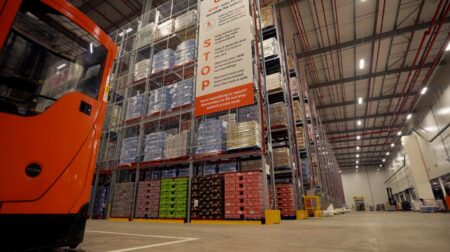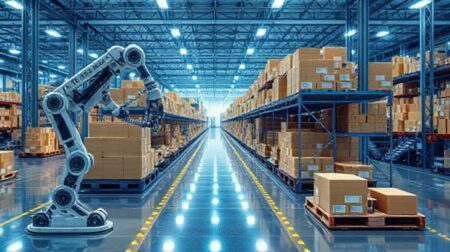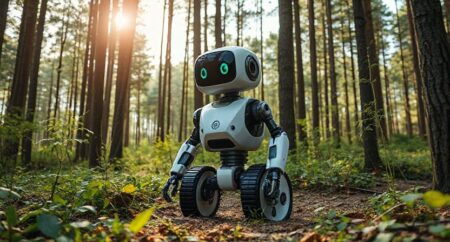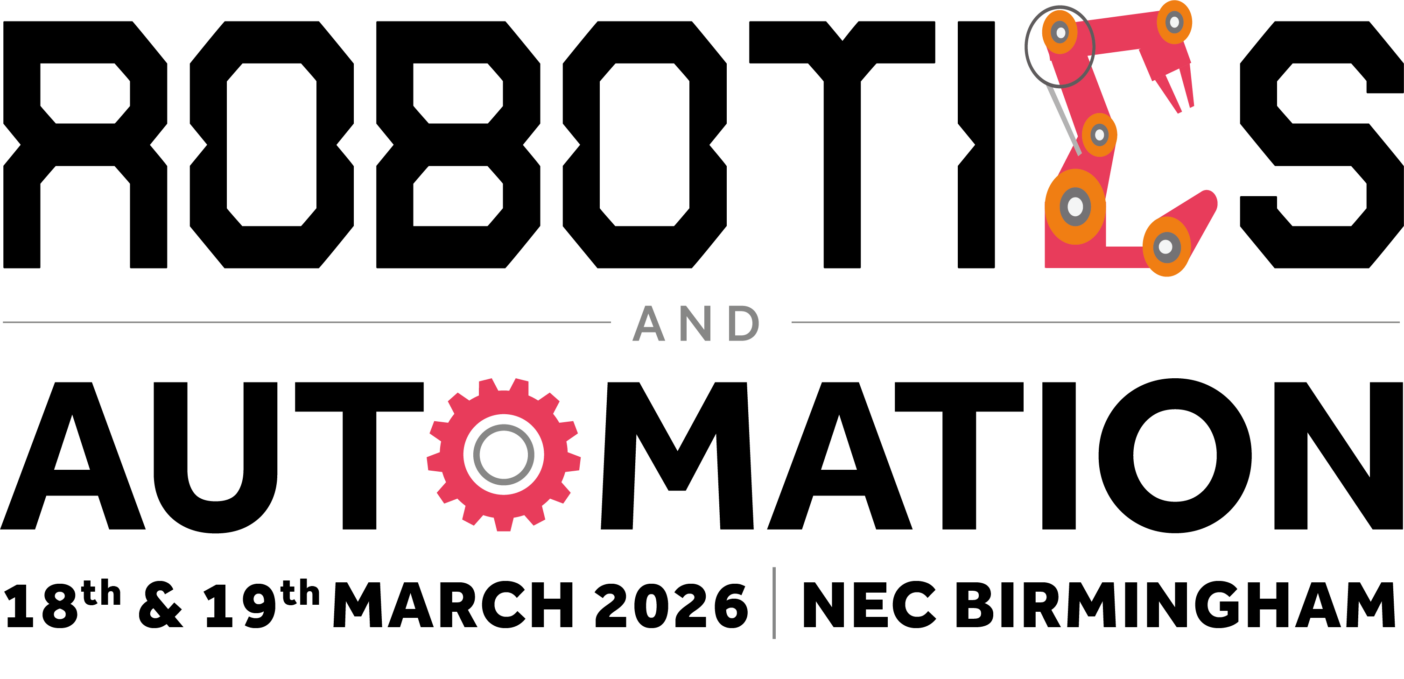It is no longer a surprise that businesses are turning to robotics and automation to improve the efficiency of their daily operations – companies around the world have started to realise that these technologies are essential to remaining competitive.
This year in particular, the rise of generative artificial intelligence (AI) systems such as ChatGPT was a dominant topic, not just in industry circles, but it frequently appeared in national headlines. Technologies that capture the benefits of these and other machine-learning algorithms are set to be key innovations in 2024.
Newer areas of deployment for robotics, such as in surgical procedures, are also set to boom. The establishment of new service models that reduce or eliminate the initial barrier of large capital expenditure, such as Robotics- and Software-as-a-Service (R/SaaS), means automation has become more accessible to smaller- and medium-sized businesses than ever.
According to the International Federation of Robotics, industrial robot installations reached new heights in 2022, hitting a record 553,052 units. This signalled the second year in a row where annual installations exceeded the 500,000-unit threshold, marking additional growth to the then-record figure of 526,144 units installed in 2021.
To discover which technologies and industries are expected to see uptakes in interest or investment during the next year, Robotics & Automation Magazine spoke to a range of key players across the robotics and automation value chain. They offered their thoughts on what they expect to drive these industries forward in 2024, with these record highs set to continue into the new year…
What types of equipment and technology do you expect to see companies increase their investment in in 2024?
 Jamie Mottershead, technical director, Renovotec: I expect businesses will continue to increase investment in AMR (autonomous mobile robot) solutions in 2024. Challenging market conditions for most sectors mean that businesses are continuing to look for constant evolution of a product, and AMRs can provide this by improving productivity, accuracy and uptime. Combine that with the flexibility and scalability that AMRs provide, then you can achieve continuous improvement by implementing complementary solutions as technology continues to evolve.
Jamie Mottershead, technical director, Renovotec: I expect businesses will continue to increase investment in AMR (autonomous mobile robot) solutions in 2024. Challenging market conditions for most sectors mean that businesses are continuing to look for constant evolution of a product, and AMRs can provide this by improving productivity, accuracy and uptime. Combine that with the flexibility and scalability that AMRs provide, then you can achieve continuous improvement by implementing complementary solutions as technology continues to evolve.
 Chris Roberts, head of industrial robotics, Cambridge Consultants: I would expect to see more custom automation development in 2024 as companies realise that they can only go so far with off-the-shelf solutions to automation. Often the challenge is unique and standard solutions are not suitable. So custom developments, when an automation solution is tailored to specific needs, are something we will see increasing investment in in 2024. A lab automation solution that’s right for a chemistry lab won’t be suitable for a biology lab, so if that lab wants to really increase its throughput and digital automation, then a custom solution is needed. The good news is, those companies that have begun investing are already starting to see dividends, which is why we expect investment to increase. The simplifications to the R&D tax credit system announced in the government’s Autumn Statement will further incentivise this behaviour.
Chris Roberts, head of industrial robotics, Cambridge Consultants: I would expect to see more custom automation development in 2024 as companies realise that they can only go so far with off-the-shelf solutions to automation. Often the challenge is unique and standard solutions are not suitable. So custom developments, when an automation solution is tailored to specific needs, are something we will see increasing investment in in 2024. A lab automation solution that’s right for a chemistry lab won’t be suitable for a biology lab, so if that lab wants to really increase its throughput and digital automation, then a custom solution is needed. The good news is, those companies that have begun investing are already starting to see dividends, which is why we expect investment to increase. The simplifications to the R&D tax credit system announced in the government’s Autumn Statement will further incentivise this behaviour.
 Jonas Nyvang, CEO and co-founder, Stilfold: Next year we anticipate more investment in areas like collaborative robots, AI integration for enhanced decision-making, and advanced sensor technologies. These investments are critical for improving safety and efficiency in robotics. We also expect to see breakthroughs in machine learning algorithms to make robots more adaptive and autonomous, significantly enhancing their capabilities. Finally, we hope to see an upswing in robotics adoption, particularly in emerging economies facing labour shortages, but also in developed markets seeking greater precision and efficiency. Especially in the EU, we will see a new wave of robotics applications and technologies across healthcare, manufacturing and logistics.
Jonas Nyvang, CEO and co-founder, Stilfold: Next year we anticipate more investment in areas like collaborative robots, AI integration for enhanced decision-making, and advanced sensor technologies. These investments are critical for improving safety and efficiency in robotics. We also expect to see breakthroughs in machine learning algorithms to make robots more adaptive and autonomous, significantly enhancing their capabilities. Finally, we hope to see an upswing in robotics adoption, particularly in emerging economies facing labour shortages, but also in developed markets seeking greater precision and efficiency. Especially in the EU, we will see a new wave of robotics applications and technologies across healthcare, manufacturing and logistics.
What technological advancements do you hope/expect to see in 2024 across robotics and/or automated systems?
 Stephanie Feigenbaum, lead, process automation, REdirect Consulting: Automated processes provide faster, more efficient results. As the industry becomes more attuned to the benefits and value automation can deliver, such tools are now becoming more widely incorporated into tech solutions and therefore adoption rates of automation are also following suit. There are certain types of automation advancing more than others, as adoption becomes more widespread. For example, various machine-learning technologies have become more accurate the more they are used because they have a wider set of data to learn from – the more we use it, the better and more helpful it will become. While AI/automation continues to gain interest and is expected to be one of the most widely adopted tools in 2024, it’s important to automate the right processes — otherwise, companies may be throwing money and technology at a problem without creating a solution.
Stephanie Feigenbaum, lead, process automation, REdirect Consulting: Automated processes provide faster, more efficient results. As the industry becomes more attuned to the benefits and value automation can deliver, such tools are now becoming more widely incorporated into tech solutions and therefore adoption rates of automation are also following suit. There are certain types of automation advancing more than others, as adoption becomes more widespread. For example, various machine-learning technologies have become more accurate the more they are used because they have a wider set of data to learn from – the more we use it, the better and more helpful it will become. While AI/automation continues to gain interest and is expected to be one of the most widely adopted tools in 2024, it’s important to automate the right processes — otherwise, companies may be throwing money and technology at a problem without creating a solution.
 Bjoern Klaas, managing director, Protolabs: Soft robotics and new materials will have the biggest impact on how robotics manufacturing will develop in the year to come and beyond. Soft robotics, such as grippers that enable robots to perform more logistical tasks, is expected to have a compound annual growth rate of 35.1% between 2022 and 2027, with biomedicine, food and agriculture set to benefit. Using new materials and technology requires several iterations for testing and refinement, so digital manufacturing is a key element in speeding up the development cycle.
Bjoern Klaas, managing director, Protolabs: Soft robotics and new materials will have the biggest impact on how robotics manufacturing will develop in the year to come and beyond. Soft robotics, such as grippers that enable robots to perform more logistical tasks, is expected to have a compound annual growth rate of 35.1% between 2022 and 2027, with biomedicine, food and agriculture set to benefit. Using new materials and technology requires several iterations for testing and refinement, so digital manufacturing is a key element in speeding up the development cycle.
 Rhyce Dawson, associate director, TMX Transform: Rather than direct advancements in the mechanical side of things, I’d like to see some advancements in the financial side. I’d like to see more entry-level advancements in automation technology, lowering the barrier to entry combined with a push towards business models such as RaaS. There is a large gap between those who can invest in high automation and those who simply cannot justify the spending. Technology with a lower threshold would bridge the gap for smaller organisations, and financial models that support low initial capital entry would push these organisations to compete with the larger companies regarding the cost to serve.
Rhyce Dawson, associate director, TMX Transform: Rather than direct advancements in the mechanical side of things, I’d like to see some advancements in the financial side. I’d like to see more entry-level advancements in automation technology, lowering the barrier to entry combined with a push towards business models such as RaaS. There is a large gap between those who can invest in high automation and those who simply cannot justify the spending. Technology with a lower threshold would bridge the gap for smaller organisations, and financial models that support low initial capital entry would push these organisations to compete with the larger companies regarding the cost to serve.
 Paul Dodd, chief innovation officer, Huboo: The use of robotics and automation has the potential to be transformational for the fulfilment and warehousing industry. I used to think meaningful advances in this field were 15 years away. However, with the recent AI breakthroughs, I think we’re now just two to three years from commercial trials and around five years from commoditisation. While much of the attention surrounding generative AI and large language models has been on desk jobs and knowledge workers, these technologies have amazing potential in the field of robotics. AI-based image recognition is coming on in leaps and bounds, and when you put this technology into robots, you’re going to get a machine that is far more capable of adapting to its surroundings. Likewise, the big breakthrough with ChatGPT and LLMs is that they have enabled non-technical humans to converse with and issue interpretable commands to machines. For fulfilment companies, this could be transformative on the warehouse floor, allowing existing warehouse teams to direct the robots in the moment, rather than requiring engineers to pre-programme them beforehand.
Paul Dodd, chief innovation officer, Huboo: The use of robotics and automation has the potential to be transformational for the fulfilment and warehousing industry. I used to think meaningful advances in this field were 15 years away. However, with the recent AI breakthroughs, I think we’re now just two to three years from commercial trials and around five years from commoditisation. While much of the attention surrounding generative AI and large language models has been on desk jobs and knowledge workers, these technologies have amazing potential in the field of robotics. AI-based image recognition is coming on in leaps and bounds, and when you put this technology into robots, you’re going to get a machine that is far more capable of adapting to its surroundings. Likewise, the big breakthrough with ChatGPT and LLMs is that they have enabled non-technical humans to converse with and issue interpretable commands to machines. For fulfilment companies, this could be transformative on the warehouse floor, allowing existing warehouse teams to direct the robots in the moment, rather than requiring engineers to pre-programme them beforehand.
In what regional/global markets do you expect to see increased interest and investment in robotics and automation in 2024?
 Michael Brandl, EVP operations software EMEA, Körber Business Area Supply Chain: The demand for flexible automation solutions is growing continuously across EMEA; however, at the same time, we have observed that the implementation of such solutions can also harbour complexities. This challenge especially applies to system integration and getting software and automation solutions to successfully interact as one holistically integrated solution.
Michael Brandl, EVP operations software EMEA, Körber Business Area Supply Chain: The demand for flexible automation solutions is growing continuously across EMEA; however, at the same time, we have observed that the implementation of such solutions can also harbour complexities. This challenge especially applies to system integration and getting software and automation solutions to successfully interact as one holistically integrated solution.
 Gavin Harrison, UK lead, warehouse automation, Element Logic: While historically Europe has been at the forefront of warehouse automation, it’s looking likely that the two main zones of growth going forward will be the Americas and Asia-Pacific. And it’s perhaps not surprising that the main areas of investment are centred in the world’s warehousing powerhouses, the US and China. While North America will undoubtedly continue to expand its investments in warehouse automation, it’s Asia-Pacific that will command the highest market share of warehouse robotics and automation systems in 2024. Nations like South Korea, Japan and India are already joining China as big investors in robotics, and this only looks set to get stronger.
Gavin Harrison, UK lead, warehouse automation, Element Logic: While historically Europe has been at the forefront of warehouse automation, it’s looking likely that the two main zones of growth going forward will be the Americas and Asia-Pacific. And it’s perhaps not surprising that the main areas of investment are centred in the world’s warehousing powerhouses, the US and China. While North America will undoubtedly continue to expand its investments in warehouse automation, it’s Asia-Pacific that will command the highest market share of warehouse robotics and automation systems in 2024. Nations like South Korea, Japan and India are already joining China as big investors in robotics, and this only looks set to get stronger.
However, I still believe there is a huge amount of growth potential still within the UK market as, when compared to our European counterparts, businesses are still lagging behind – especially in the e-commerce marketplace. I also believe that in complicated times we tend to see smaller companies navigate the difficult waters and make swift decisions, using their investment in automation as a way to gain ground on some of the larger players who have a more risk-averse business outlook.
 Robert Vines, country manager for the UK, Ireland & Nordics, TSC Printronix Auto ID: China undoubtedly leads global growth of industrial robots but, in the region I look after the UK, Ireland and Nordics, and I am definitely seeing increased interest in robotics, especially from the pre-pack pharmaceutical industry and the apparel sector.
Robert Vines, country manager for the UK, Ireland & Nordics, TSC Printronix Auto ID: China undoubtedly leads global growth of industrial robots but, in the region I look after the UK, Ireland and Nordics, and I am definitely seeing increased interest in robotics, especially from the pre-pack pharmaceutical industry and the apparel sector.
In what industries do you expect to see increased interest and investment in robotics and automation in 2024?
 Simon Jones, UK sales executive, Exotec: E-commerce continues to be an increasingly popular way for people to shop, putting enormous pressure on the supply chain as shoppers expect to receive their orders as quickly as possible. For the UK in particular, the e-commerce market is expected to grow by almost 22% each year between 2023 and 2028. Retail stores won’t be going away any time soon either. There remains significant demand for physical premises in many retail segments, so there is a need to maintain consistent stock levels.
Simon Jones, UK sales executive, Exotec: E-commerce continues to be an increasingly popular way for people to shop, putting enormous pressure on the supply chain as shoppers expect to receive their orders as quickly as possible. For the UK in particular, the e-commerce market is expected to grow by almost 22% each year between 2023 and 2028. Retail stores won’t be going away any time soon either. There remains significant demand for physical premises in many retail segments, so there is a need to maintain consistent stock levels.
Managing both e-commerce and retail operations in the same warehouse can be tricky, especially when using automation. However, we expect to see an increasing number of organisations doing this, as the presence of flexible robotics systems makes it much easier to operate fulfilment for both e-commerce and store replenishment from the same site and even in the same automation. The potential cost savings from the use of a single automation system to handle both e-commerce and physical retail are huge, with some of the benefits including no duplication of stock and a much smaller warehouse footprint, leading to big savings on property costs.
 Sascha Dobbelaere, founder and CEO, Tweave.tech: Automotive has always been at the forefront of automation. Or at least on the assembly line. But the tools have been minimal – for example, if you look at seat cover manufacturing, this is primarily due to the nature of automating textile processes. However, as we progress, automotive will always have a great desire for automation – aerospace, I would imagine, works in very similar ways. The biggest surprises I would expect to find are in retail. As we see a further evolution of omni-channel thinking, I hope to see retail robots pop up to help customers find products on the shelves, handling basic questions or even suggesting products.
Sascha Dobbelaere, founder and CEO, Tweave.tech: Automotive has always been at the forefront of automation. Or at least on the assembly line. But the tools have been minimal – for example, if you look at seat cover manufacturing, this is primarily due to the nature of automating textile processes. However, as we progress, automotive will always have a great desire for automation – aerospace, I would imagine, works in very similar ways. The biggest surprises I would expect to find are in retail. As we see a further evolution of omni-channel thinking, I hope to see retail robots pop up to help customers find products on the shelves, handling basic questions or even suggesting products.
 Mike Harvey, managing director, 1st Move International: One key trajectory involves the heightened integration of AI and machine learning algorithms into robotic systems. This integration is expected to enhance the adaptability and decision-making capabilities of robots, enabling them to operate more autonomously and efficiently. Moreover, a surge in collaborative robots, or cobots, is foreseen, where robots will work alongside humans seamlessly, particularly in industries such as manufacturing and logistics. This collaborative approach is not only expected to improve overall productivity but also contribute to a safer and more ergonomic work environment.
Mike Harvey, managing director, 1st Move International: One key trajectory involves the heightened integration of AI and machine learning algorithms into robotic systems. This integration is expected to enhance the adaptability and decision-making capabilities of robots, enabling them to operate more autonomously and efficiently. Moreover, a surge in collaborative robots, or cobots, is foreseen, where robots will work alongside humans seamlessly, particularly in industries such as manufacturing and logistics. This collaborative approach is not only expected to improve overall productivity but also contribute to a safer and more ergonomic work environment.
From the perspective of a moving expert, the implications of these trends in robotics and automation are substantial. Automated systems will likely play a pivotal role in streamlining logistics and supply-chain operations within the moving industry. Advanced robotic technologies could be employed for tasks such as inventory management, packing and even transportation, reducing manual labour and increasing operational efficiency.
 Stewart Marsh, head of aerospace, Cambridge Consultants: In aerospace, I expect to see increased interest and investment in UAS technologies and the associated ecosystem. Uncrewed aerial vehicles (UAVs) will become more autonomous, allowing fleets of collaborating UAVs to complete mission-based tasks such as inspection with minimal operator supervision. The ecosystem will evolve to provide 3D digital twins of airspace and real-time tracking of UAVs. This will drive investment in sensors such as radar to monitor the skies from the ground.
Stewart Marsh, head of aerospace, Cambridge Consultants: In aerospace, I expect to see increased interest and investment in UAS technologies and the associated ecosystem. Uncrewed aerial vehicles (UAVs) will become more autonomous, allowing fleets of collaborating UAVs to complete mission-based tasks such as inspection with minimal operator supervision. The ecosystem will evolve to provide 3D digital twins of airspace and real-time tracking of UAVs. This will drive investment in sensors such as radar to monitor the skies from the ground.









